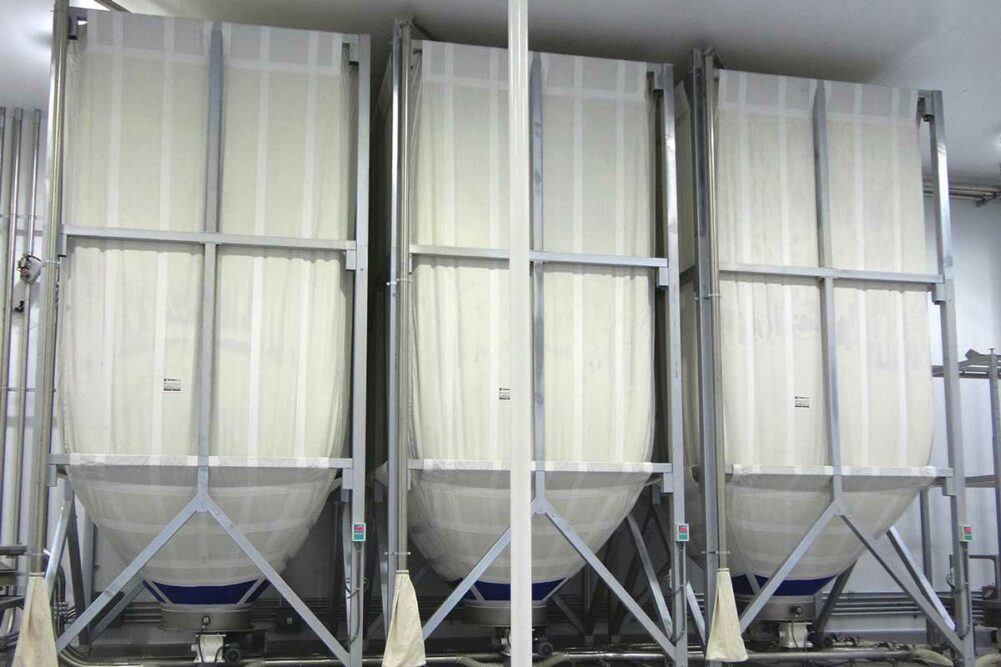Bulk ingredient handling systems store, weigh and deliver the major ingredients, often flour, sugar or a liquid sweetener, to the mixing bowl. Automating or expanding these systems often offer the fastest return on investment.
“Your biggest payback is on large volume storage systems so you can maximize your payload of product delivery, and that obviously takes up a lot of space,” said Darren Adams, vice president, engineering, The Fred D. Pfening Co.
Typically, these ingredients are stored in silos. Despite how large these storage and delivery systems can be, they’re often quite flexible in where they can be or even how they are configured.
Silos have the historic advantage of being placed outside or under temporary shelters.
“Probably about 75% of the storage can be placed anywhere,” Mr. Adams said. “The heart of the system is the blower, whether you’re doing a vacuum pressure system or a pump for liquid ingredients, and all of that can sit outside with the storage vessel.”
For outdoor storage, bakers should consider a concrete pad as a foundation for the silo and ancillary equipment. A good drainage system allows rain and snow to run away from the equipment.
“We see a lot of older indoor silo solutions that take up interior space,” said Pieter Van Hoecke, business development, North America, Spiromatic. “Often these have been selected to avoid outdoor storage that exposes the silos and their contents to extreme temperature fluctuations.”
Highly insulated outdoor storage solutions like glass reinforced polyester (GRP) can provide safe and hygienic storage outside. They also help bakers comply with National Fire Protection Association standards for avoiding dust explosion risks.
Electrical, compressed air and other utilities will also need to reach the bulk storage and delivery system, and the delivery system needs to reach into the bakery and the delivery point. Here is where constraints can come into play.
“There are physical limitations as to how far we can travel, so if you have to put the silo at the other end of the parking lot, you will probably have to put in a smaller intermediate storage facility along the way,” Mr. Adams explained.
If the bakery has a footprint restriction, even outside, ingredient handling systems have the flexibility for bakers to get creative with placement.
“Fortunately, there can be a fair amount of flexibility in where equipment is located” said Jason Stricker, director of sales and marketing, Shick Esteve. “As long as we can stay within acceptable distances we can remotely locate equipment and still maintain precise accuracies. Suppliers are often accustomed to working with space constrained facilities, so we have developed equipment designs that allow us to maximize the spaces available to us. This is especially true when working in older bakeries.”
Equipment suppliers can get creative when it comes to designing a bulk storage unit to fit in the allocated space, whether that’s going vertical or using a horizontal silo or smaller bins.
“A good workaround for tight space is putting the bulk systems in first but outside and then have it delivering to smaller bins that can be strategically placed indoors,” Mr. Adams said.
As bakers look for opportunities to expand their ingredient handling capacity, there are plenty of factors to bear in mind.
First things first, the baker must determine how much extra storage is needed, said Jerry Murphy, vice president, sales and marketing, Gemini Bakery Equipment/KB Systems. Then the space issue must be addressed.
“See if something existing in the space can be relocated or re-oriented to accommodate equipment,” he said.
It might even be worth it to see if it’s cost-effective to raise a section of the roof.
When evaluating an area for ingredient storage, bakers should determine the environmental impact and the availability for safety features as well.
“Allow for leak containment and hazmat considerations,” said Norm Searle, sales and marketing, GOE/Amherst Stainless Fabrication. “Allow for clear and free access to the tank and associated components.”
The inside and outside of the tanks must be accessible for cleaning, too.
Other considerations are determined by specific ingredients and the process itself. Bakers need to evaluate their need for agitation, temperature control, recirculation and whether the supply lines should be drained or kept full.
“Many liquids, including those with inclusions, require constant agitation to sustain temperature control and maintain inclusions in suspension,” Mr. Searle explained. “Many ingredients are temperature sensitive, requiring temperature to be maintained in order to maintain viscosity and ingredient quality, including those liquids held in transfer piping.”
Depending upon an ingredient’s specific needs, tanks and supply lines may need jacketing to maintain the desired temperature.
This article is an excerpt from the May 2020 issue of Baking & Snack. To read the entire feature on ingredient handling, click here.





